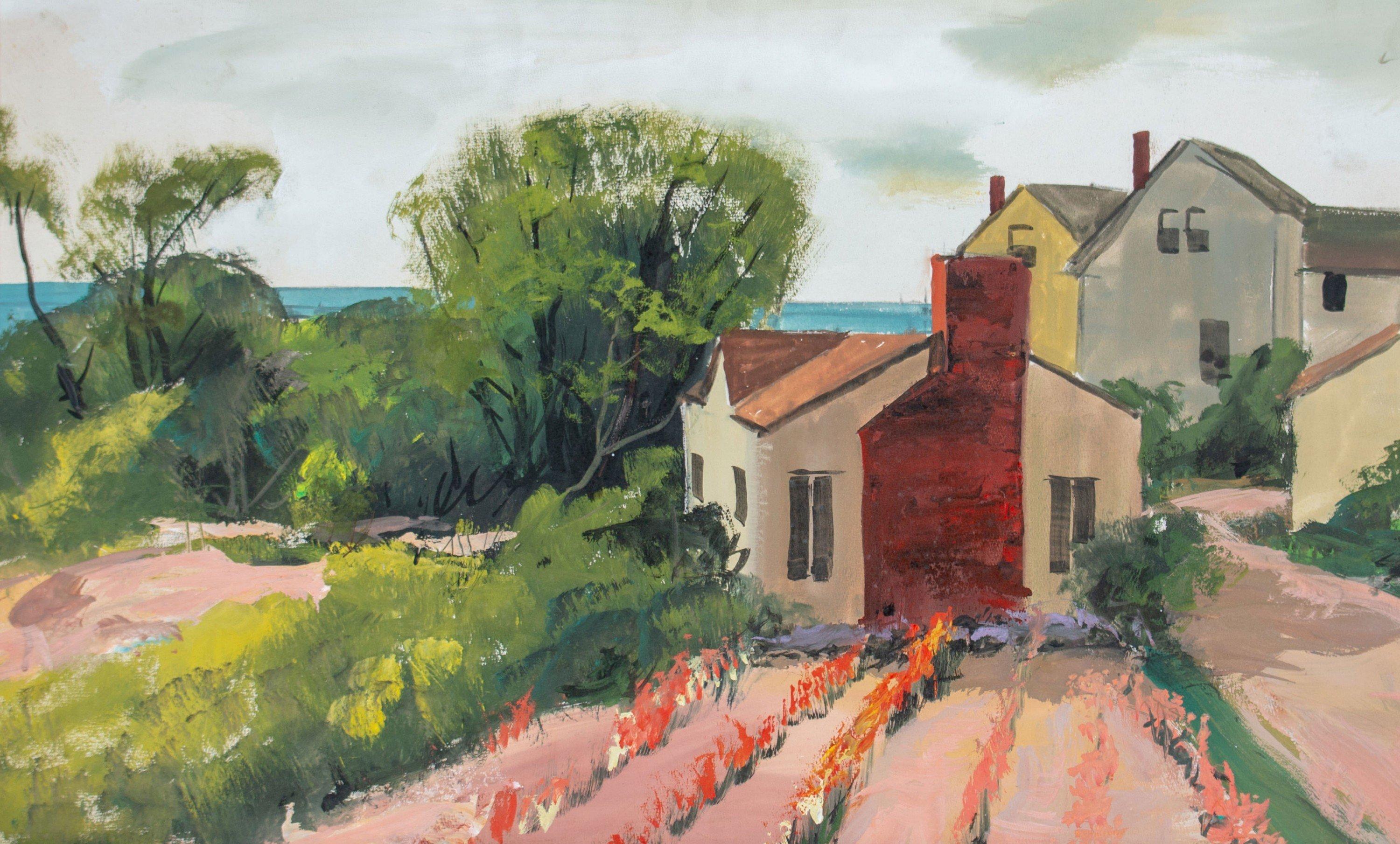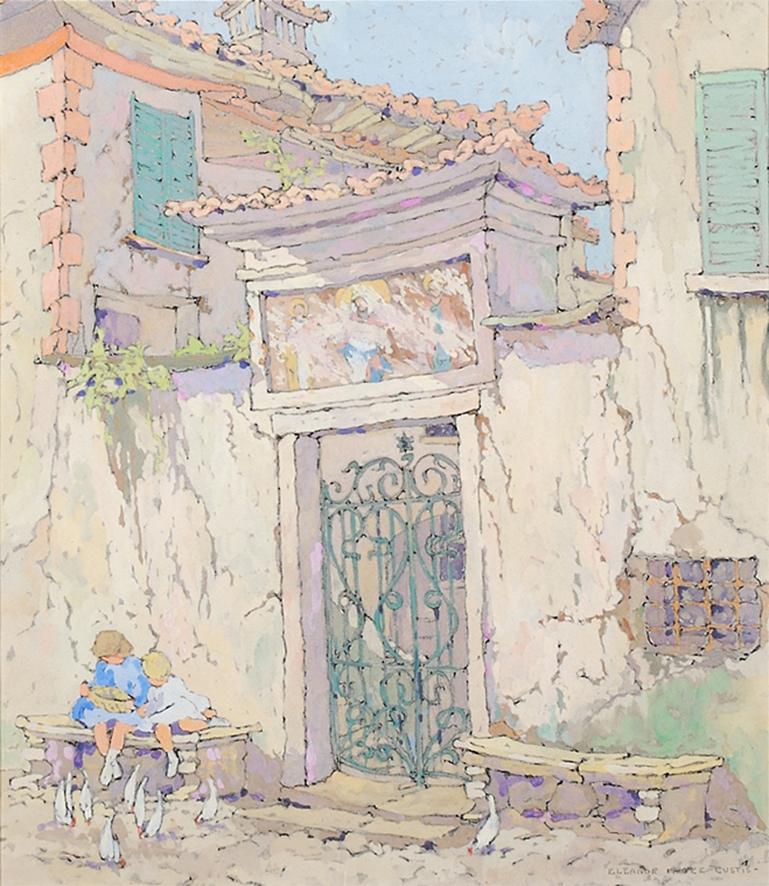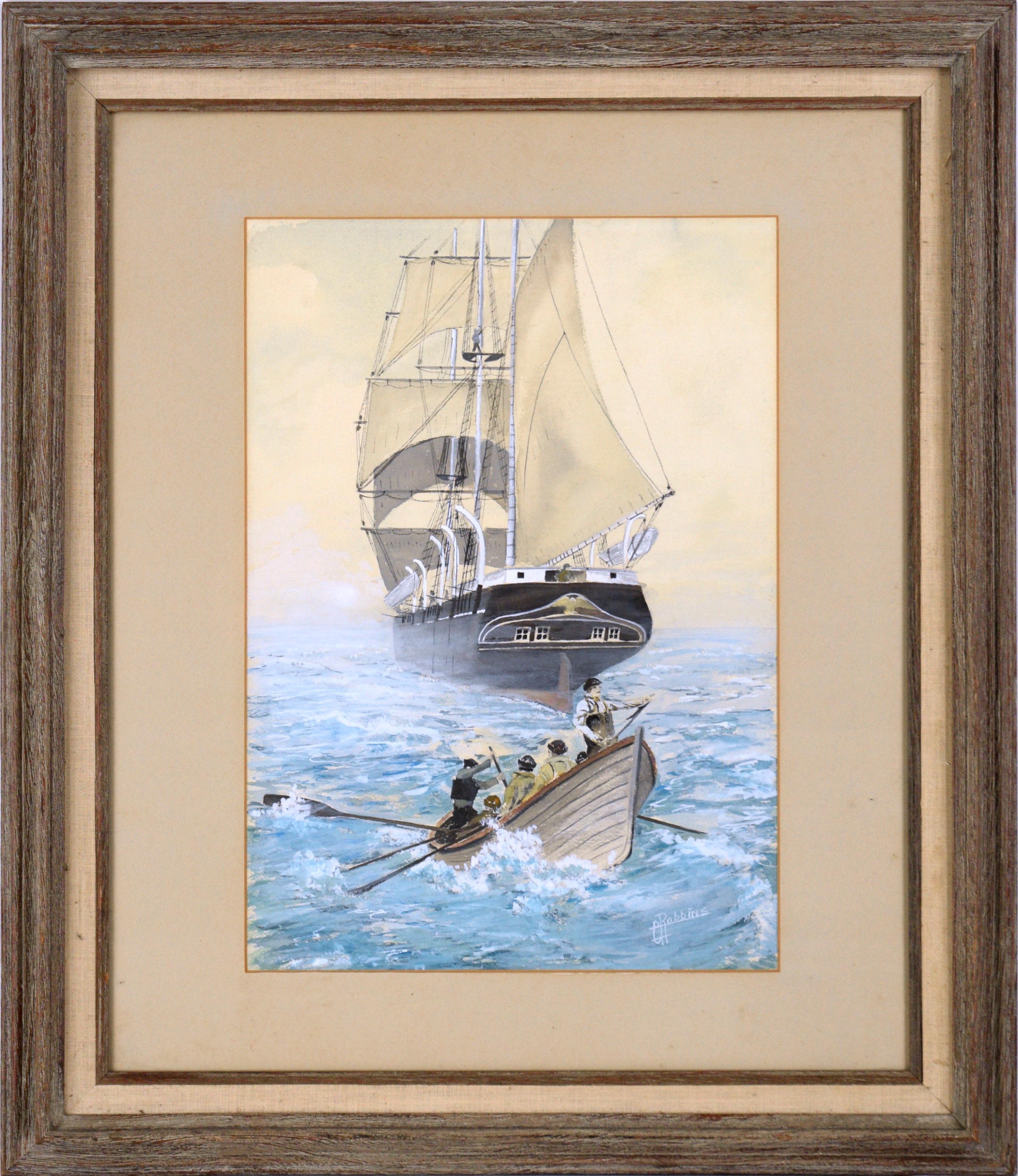Items Similar to Rock Creek, Mid-century Ohio Landscape Painting, Cleveland School
Want more images or videos?
Request additional images or videos from the seller
1 of 8
Carl Frederick GaertnerRock Creek, Mid-century Ohio Landscape Painting, Cleveland School 1950
1950
About the Item
Carl Frederick Gaertner (American, 1898-1952)
Rock Creek, 1950
Gouache on artist board
Signed and dated 1950 lower right/inscribed verso
14 x 19.5 inches
20 x 25.5 inches, as framed
Carl Gaertner was one of the greatest painters to emerge from the Cleveland School. Born in Cleveland on April 18, 1898, he graduated from East Technical high school in 1918 and attended Western Reserve College. From 1920 to 1923 he studied at the Cleveland School of Art (now the Cleveland Institute of Art) with Henry Keller. In 1922, he entered his first May Show at the Cleveland Museum of Art and was awarded a prize for an industrial oil painting. From 1925 until 1952, he was known as a pillar of the Cleveland School and one of their most prestigious painting instructors.
Gaertner’s subject matter was always drawn from the world around him. Early in his career, he focused on Cleveland and its environs. This interest never left him, but as he matured, his choice of subjects broadened. He painted watercolors and oils of Bermuda in the mid 1920s and began making frequent trips to Provincetown beginning in the 1920’s. Like other Cleveland artists, he culled inspiration from travels within the United States, notably trips through Pittsburgh’s dramatic industrial landscapes and Cambridge Springs in Pennsylvania, to the mountains of West Virginia, and to Cape Cod. From the mid 1940s until his death, he also produced paintings based on sketches made during train rides to visit galleries in New York City.
At the time of his premature death in 1952, Carl Gaertner enjoyed a considerable reputation as a master of American Scene painting. By the 1940s, Gaertner was represented by the venerable Macbeth Gallery in New York City and his paintings were exhibited in shows throughout the United States. In 1944 and 1952, Gaertner received the National Academy of Design’s highest award for individual work in a group exhibition, and his work was exhibited in the Cleveland Museum of Art’s May Show for 27 years. Gaertner’s works are in the collections of many prestigious institutions, including the Cleveland Museum of Art, the Metropolitan Museum of Art, the Chicago Institute and the Whitney Museum of American Art.
The reflective eye of Gaertner chronicled three decades of Cleveland and the landscapes of the Midwest and its people. It is all there: the growing might of industrial Cleveland; the mass-produced promise of the assembly line, giving way to a dawning awareness of lost freedom and the surrender of individuality; the love affair of Americans with nature and the ideals of Thoreau and Whitman and Frost; and the conflict between that love affair and industrial promise.
Gaertner was just achieving national acclaim at the time of his early death at the age of 54. A resurgence of enthusiasm for Gaertner and his works began in the 1970’s and has steadily increased and incrementally boosted the value of his work, with a fine rare example, “The Popcorn Man” reaching $250,000 at auction.
- Creator:Carl Frederick Gaertner (1898 - 1898, American)
- Creation Year:1950
- Dimensions:Height: 20 in (50.8 cm)Width: 25.5 in (64.77 cm)
- Medium:
- Movement & Style:
- Period:
- Condition:
- Gallery Location:Beachwood, OH
- Reference Number:1stDibs: LU176829982272
About the Seller
No Reviews Yet
Vetted Seller
These experienced sellers undergo a comprehensive evaluation by our team of in-house experts.
Established in 1975
1stDibs seller since 2022
9 sales on 1stDibs
Typical response time: 10 hours
- ShippingRetrieving quote...Ships From: Beachwood, OH
- Return PolicyA return for this item may be initiated within 14 days of delivery.
More From This SellerView All
- Flower Garden, Cape Cod, Mid-Century Cleveland School PaintingBy Carl Frederick GaertnerLocated in Beachwood, OHCarl Frederick Gaertner (American, 1898-1952) Flower Garden, Cape Cod, c. 1940s Gouache on illustration board 17.5 x 29 inches 27 x 39 inches, as framed Carl Gaertner was one of the greatest painters to emerge from the Cleveland School...Category
1940s American Realist Figurative Paintings
MaterialsGouache
- Hillside and Stream, early 20th century modernist Cleveland School paintingLocated in Beachwood, OHClara Deike (American, 1881-1964) Hillside and Stream, 1916 Gouache on paper Signed and dated lower right 22 x 18 inches 25.5 x 21.5 inches, framed A graduate of the Cleveland Schoo...Category
1910s American Modern Figurative Paintings
MaterialsGouache
- Mid Century Modernist Watercolor Landscape with Horse, Cleveland SchoolBy William SommerLocated in Beachwood, OHWilliam Sommer (American, 1867–1949) Spring Beauty Watercolor on paper Signed lower right 12.5 x 17 inches 18 x 22.75 inches, framed William Sommer is seen as a key person in bringi...Category
Mid-20th Century American Modern Figurative Paintings
MaterialsWatercolor
- Boat at the End of a Jetty, Seascape Coastal New England SceneBy Jonas LieLocated in Beachwood, OHJonas Lie (American, 1880-1940) Boat at the End of a Jetty OIl on canvas board Signed lower right 12.75 x 10.5 inches 18.75 x 16.75 inches, framed Jonas Lie was a prolific painter, ...Category
Early 20th Century American Impressionist Figurative Paintings
MaterialsOil
- 20th century painting of monks in Venice, Italian pink figural workBy Louis BosaLocated in Beachwood, OHLouis Bosa (Italian-American, 1905–1981) Island of the Monks, c. 1930 Oil on masonite Signed lower right 14 x 24 inches 23 x 33 inches, framed Born in Codroipo, a small village only...Category
1930s Expressionist Figurative Paintings
MaterialsOil
- Early 20th Century Impressionist Seascape, Harbor and Town SceneBy Charles Salis KaelinLocated in Beachwood, OHCharles Salis Kaelin (American, 1858–1929) Harbor and Town Oil on canvas 25.75 in. h. x 27.75 in. w., as framed 18 in. h. x 20 in. w., canvas Described as an artist whose "love of nature amounted to a passion," Charles Salis Kaelin was one of the earliest American exponents of Divisionism. A respected member of the art colony at Rockport, Massachusetts, Kaelin's colorful renderings of Cape Ann...Category
20th Century Post-Impressionist Landscape Paintings
MaterialsOil
You May Also Like
- 1840 rare watercolor, Native American encampment, Western Indian Unknown artistLocated in Buffalo, NYA rare mid 19th Century watercolor depicting Native Americans approaching a fort. The subjects appear to be from a Northern Plains Tribes, and arre approaching a palisades style f...Category
1840s American Realist Landscape Paintings
MaterialsPaper, Watercolor, Gouache
- The GatewayBy Eleanor Parke CustisLocated in New York, NYSigned (lower right): ELEANOR PARKE CUSTISCategory
20th Century American Realist Landscape Paintings
MaterialsPaper, Gouache
- Pulp Magazine Marine Combat Scene Shoot Out in Blue NoirLocated in Miami, FLWhat makes this work important? It's not that it's a commissioned artwork for a men's 60s pulp adventure magazine depicting the instant a soldier is shot. The big point of the painting is how brilliantly the formal elements are thought out, designed, and executed. John McDermott tells a story using a complex figural composition in an unexpected wide-angle vision. The work is as abstract as it is representation. His use of light is significant because it creates a high-contrast two-color style that bears the mark of its creator. This is a work done by a master artist/illustrator without peers compared to artists living today. If the contemporary art world gave awards for draftsmanship, painting technique, and graphic design .... John McDermott would win the highest accolades. Initialed lower left - unframed John McDermott (August 30, 1919 – April 20, 1977), also known under the pen names J.M. Ryan and Mariner, was an American illustrator and author noted for action and adventure illustrations.[1] McDermott worked as an in-between and effects animator for Walt Disney Studios and as a US Marine combat artist,before establishing himself as a cover illustrator for 1950s paperbacks and pulp magazines such as Argosy, American Weekly, and Outdoor Life. Under his J.M. Ryan pen name, he wrote the novels The Rat Factory (1971), a derogatory satire of Walt Disney and the Disney studio; Brooks Wilson Ltd (1967), on which the 1970 film Loving was based; and Mother's Day (1969) about Ma Barker. Under his own name, he novelized director-writer Bo Widerberg's screenplay for the 1971 film Joe Hill, which would be his final published book. Early life John Richard McDermott was born 30 August 1919 in Pueblo, Colorado, the younger of two sons of Henry McDermott, an oil broker. McDermott was a young child when his father committed suicide.[4] The family eventually moved to Los Angeles where McDermott's mother, Hazel, worked in a beauty parlor. He graduated from Hollywood High School in 1936. Although he had had no formal art education, he took a job as an artist at Walt Disney Animation Studios. Career Disney At Disney, McDermott worked as an in-betweener and effects animator on Brave Little Tailor, Pinocchio, The Reluctant Dragon and Fantasia. His experiences while working at Disney, particularly during the time of the 1941 Disney animators' strike, would later become the basis for his 1969 satirical novel The Rat Factory. McDermott left Disney to fight with US forces during World War II. US Marines McDermott World War II sketch titled "Buddy is Wounded" On September 29, 1942, McDermott enlisted with the US Marine Corps. He served as a "pistol and palette" combat artist assigned to the map-making section. As a sergeant with the III Amphibious Corps, McDermott was involved in battles in the South Pacific theater of war, documenting the Guam, Okinawa and the Guadalcanal Campaigns. McDermott considered his wartime years to be his art education. "In the Marines, as a combat artist, I traveled with the troops and for three years got all the drawing opportunity anyone could want. My work changed enormously during this time and I’m sure it was due to constant drawing, every single day, from life, just putting down what I saw around me. In a few instances it was a dangerous kind of scholarship." According to the Marine Corps history journal Fortitudine, McDermott was so prolific that his contemporary style pen-and-ink sketches became easily recognizable to both Marines, from published work in Leatherneck Magazine, and civilians, from glossy copies supplied by the Marine Corps to the nation's press.His wartime art appears in World War II history books and is displayed at the Pentagon and the National Museum of the Marine Corps. Illustration Following the end of World War II, McDermott moved from California to New York City to work as a freelance illustrator. McDermott made his reputation drawing modern action, war and adventure scenes. His work adorned the covers and inside story pages of popular pulp magazines of the 1950s such as Argosy, Adventure, Blue Book, Outdoor Life and American Weekly. McDermott's illustrations appeared on numerous covers of 1950s paperback novels published by Dell, Fawcett Gold Medal, Bantam Mystery and others. His action graphics were geared toward thriller and detective genres, such as Donald Hamilton's Matt Helm books Murderers' Row and The Betrayers. He also created covers for science fiction comic titles such as Voyage to the Deep[citation needed] and horror-themed paperbacks such as the classic 1955 science fiction novel The Body Snatchers...Category
1960s American Realist Figurative Paintings
MaterialsIllustration Board, Gouache
- Battle Scene At Sea World War II . Dead Soldiers and Blood Red SeaBy Mort KünstlerLocated in Miami, FLThe artist invents and then captures a moment of a peak drama with soldiers being shot and bombs exploding. It's beautifully rendered. This work was published as a two-page spread...Category
1960s American Realist Landscape Paintings
MaterialsGouache
- Rowing to Shore - Nautical Seascape in Gouache on PaperLocated in Soquel, CANoble nautical scene of a small rowboat coming to shore from a larger sailing vessel by George A. Robbins (American, 1918-2010). In the foreground, sever...Category
Late 20th Century American Realist Landscape Paintings
MaterialsPaper, Gouache
- Impressionist Coastal Fisherman LandscapeBy William HoeyLocated in Houston, TXGouache painting by William Hoey featuring a small fisherman walking to the coast. Circa 1970s. Dimensions of painting without frame: H 6.5 in. x W 8.5 in. x D .25 in. Artist Biogr...Category
1970s American Realist Landscape Paintings
MaterialsGouache
Recently Viewed
View AllMore Ways To Browse
Industrial School
Mid Century Auction
Rock Of Ages Vintage
Vintage Cleveland Sign
Carl Master
Assembly Line
Virginia Rare
Artist 1970s Mountains Landscape
Oils 1920s
Watercolor Cape Cod
Western Cape
Bermuda Art Painting
Vintage Cape May
Bermuda Painting
Vintage Whitman
Henry Thoreau
Bermuda Oil Painting
Painting Signed By Whitman




